The use of benzodiazepines for the treatment of anxiety disorders has long been controversial. It has divided doctors into those who emphasise problems with their use and avoid them, and those who continue to prescribe them, albeit reluctantly and even secretively. Complicating matters further, some doctors express one opinion about benzodiazepines publicly and quite the opposite view privately. Benzodiazepines are also a common reason for the rift between patients who believe that they are useful and doctors who refuse to prescribe them because of their ‘addictiveness’. This has produced confusion in both physicians and patients. The aim of this article is to provide a balanced appraisal of the role of benzodiazepines in the treatment of anxiety disorders, emphasising how to make the most of these drugs.
History and current use of benzodiazepines
Benzodiazepines – the prototypical anxiolytics – were introduced in the early 1960s. They quickly became very popular for a variety of reasons. The most succinct explanation for their rise was the societal need for substances with calming effects. Over the centuries this need has been met mainly with alcohol. In the decade prior to the introduction of benzodiazepines, barbiturates and meprobamate were often used to alleviate anxiety and distress. However, these medications were associated with dependence, and barbiturates were lethal in overdose. Being much safer than barbiturates and meprobamate, benzodiazepines were described as ‘one of the twentieth century’s greatest inventions’ (Reference HealyHealy 2002). Small wonder, then, that in the mid-1970s they became the most widely prescribed group of psychotropic medications in the world (Reference Balter, Levine and ManheimerBalter 1974).
What caused the subsequent fall in enthusiasm for benzodiazepines? It is undoubtedly the fact that they are associated with pharmacological dependence and that difficulties in ceasing the drugs after long-term use are common. One inquiry into this matter concluded that addiction should be differentiated from non-addictive or therapeutic dependence, and that benzodiazepines were more associated with the latter, not the former (Reference SalzmanSalzman 1991). Unfortunately, this nuanced approach to benzodiazepine-induced dependence was quickly lost in the noise produced by the more vocal and influential benzodiazepine opponents.
Concerns about benzodiazepine dependence made it much easier for the newer antidepressants to be promoted for the treatment of anxiety disorders (Reference StarcevicStarcevic 2011). As a result, by the end of the 1990s, most guidelines endorsed selective serotonin reuptake inhibitors (SSRIs) and serotonin and noradrenaline reuptake inhibitors (SNRIs) as the pharmacological treatment of choice for anxiety disorders. However, in 1999, one panel of world experts still recommended benzodiazepines for anxiety disorders, even for prolonged periods of time (Reference Uhlenhuth, Balter and BanUhlenhuth 1999).
Studies confirm that benzodiazepines remain the most commonly used medications for anxiety disorders in the USA (55–94% of patients with anxiety disorders were treated with benzodiazepines (Reference StahlStahl 2002)), despite efforts to promote antidepressants as first-line pharmacological treatment for these conditions (Reference Bruce, Vasile and GoismanBruce 2003; Reference Vasile, Bruce and GoismanVasile 2005). Frequent use of benzodiazepines has also been reported in several European countries (Reference Smolders, Laurant and van RijswijkSmolders 2007; Reference Demyttenaere, Bonnewyn and BruffaertsDemyttenaere 2008).
There are several reasons for the continuing popularity of benzodiazepines (Box 1), including their consistent effectiveness for relieving anxiety, tension and various physical symptoms of anxiety; quick onset of therapeutic action; relatively good tolerability; possibility of administration on an ‘as-needed’ (p.r.n.) basis; and relative safety in overdose. Problems with antidepressants in the treatment of anxiety disorders have also contributed to the continuing attractiveness of benzodiazepines. The following case vignette illustrates a common clinical scenario.
BOX 1 Reasons for benzodiazepine use in anxiety disorders
-
• Consistent effectiveness for relieving anxiety, tension, sleep disturbance and various physical symptoms of anxiety (particularly apparent in acute settings and when there is a need for quick alleviation of anxiety and distress)
-
• Quick onset of anti-anxiety effect (often within minutes of administration)
-
• Relatively good tolerability (side-effects rarely appear to be a reason for discontinuation)
-
• Possibility of administration on an ‘as-needed’ (p.r.n.) basis, which may be useful in a variety of settings
-
• Relative safety in overdose (especially if not taken in combination with other medications)
-
• Some disappointment with antidepressants in the treatment of anxiety disorders (their slow onset of therapeutic action, unpredictable and occasionally troublesome side-effects, inconsistent or unreliable effectiveness in some cases)
A typical clinical case vignette
A 56-year-old woman started taking diazepam 3 years ago because of panic attacks and anxiety. This was at about the time she was going through a difficult divorce. Her mood has fluctuated over the years and she has had at least two episodes of depression. Treatment with several antidepressants failed because of intolerable side-effects: she was ‘sick in the stomach’, ‘zonked out’ or felt like she was going to ‘explode’. At the time of referral, she was on a stable regimen of diazepam 15 mg/day, and occasionally 20 mg/day. She felt that diazepam helped her to deal with her financial worries and cope better with her adult children. She also believed that diazepam made it possible for her to sleep and relax. She denied experiencing any side-effects and was able to find a new job. At the assessment, she exhibited no significant symptoms of anxiety and she did not feel depressed. There was no history of substance misuse problems. She believed that ceasing diazepam would be premature, but was willing to reconsider it in the future.
Mechanism of action, clinical effects and types of benzodiazepines
It is widely believed that benzodiazepines enhance the effects of the neurotransmitter gamma-aminobutyric acid (GABA). They do so through action at benzodiazepine receptors. Alleviation of fear is a result of GABA-induced inhibition of neuronal transmission that occurs in the amygdala, located in the brain stem, and thought to mediate brain circuits involved in the appraisal of threat and experience of fear.
Benzodiazepines produce a calming effect, decrease anxiety, relax tense muscles, alleviate symptoms of fear-related bodily arousal (e.g. heart racing, trembling), and promote sleep. It appears that soon after taking a benzodiazepine, many people experience a pleasant ‘glowing’ feeling and a sense of remoteness from or indifference to their worries or fears, but it is unclear whether these effects play a significant role in motivating people with anxiety disorders to continue taking benzodiazepines. Perhaps the key characteristic of benzodiazepines is that when dosed correctly, they calm and relax without causing drowsiness, and therefore do not interfere with routine, everyday activities and functioning.
Box 2 lists commonly used benzodiazepines. The similarities between benzodiazepines are greater than their differences, and the main characteristic that distinguishes them is the duration of their action. They are usually divided into short-acting (up to 6 h), intermediate-acting (6–12 h) and long-acting (more than 12 h), although this division is not very clear. However, classification on these grounds has several practical implications.
BOX 2 Commonly used benzodiazepines
Short-acting
-
• Alprazolam
-
• Lorazepam
Intermediate-acting
-
• Oxazepam
Long-acting
-
• Diazepam
-
• Ethyl loflazepate
-
• Clorazepate
-
• Chlordiazepoxide
-
• Clonazepam
Short-acting benzodiazepines (e.g. alprazolam) need to be taken three to four times a day, which is not very practical. For this reason, they may not be suitable for long-term administration. They may be more useful for immediate, one-off alleviation of anxiety or distress and may thus be a good option for p.r.n. use. These benzodiazepines should probably be avoided if there are concerns about misuse, because of an association, albeit inconclusive (e.g., Reference Pradel, Delga and RoubyPradel 2010), between short duration of action and propensity for misuse.
Intermediate-acting (e.g. oxazepam) and long-acting benzodiazepines (e.g. diazepam, clonazepam) should ideally be taken once or twice a day and they are usually preferred for long-term treatment. Long-acting benzodiazepines may accumulate, especially when the next dose is taken before the previous doses have been eliminated from the body. This may cause unexpected and excessive drowsiness (‘hangover sedation’), especially in the elderly. As an intermediate-acting drug, oxazepam is therefore preferred by regulatory authorities in some countries.
Benzodiazepines v. antidepressants for anxiety disorders
Separating short-term and long-term treatment of anxiety disorders is somewhat artificial. Most anxiety disorders have a chronic course and the initial choice of pharmacological agent is likely to determine treatment over the subsequent months or even years. Thus, it is important to ascertain when treatment with benzodiazepines is a reasonable initial strategy (Box 3).
BOX 3 When to consider benzodiazepines for anxiety disorders
Clinical situations in which benzodiazepines may be considered as the initial treatment for anxiety disorders (with or without an antidepressant) include:
-
• panic disorder (and to a lesser extent, generalised anxiety disorder and social anxiety disorder)
-
• need for rapid symptomatic relief (e.g. for severe anxiety and frequent panic attacks)
-
• history of severe side-effects of the previously administered antidepressant(s), especially if these side-effects resulted in premature cessation of the medication
-
• absence of current or past substance misuse
Clinicians should first consider the principal cross-sectional diagnosis and whether benzodiazepines may be an effective treatment. The efficacy of benzodiazepines (especially alprazolam and clonazepam) in treating panic disorder is most convincing (e.g. Cross-National Collaborative Panic Study 1992; Reference Rosenbaum, Moroz and BowdenRosenbaum 1997). Efficacy data are less consistent for generalised anxiety disorder and social anxiety disorder (e.g. Reference Gelernter, Uhde and CimbolicGelernter 1991; Reference Davidson, Petts and RichichiDavidson 1993 Reference Rickels, Downing and SchweizerRickels 1993, Reference Rickels, DeMartinis and Aufdembrinke2000), and benzodiazepines may be useful only in their short-term treatment and/or in conjunction with antidepressants.
Benzodiazepines should ideally be used only as an adjunct in patients with post-traumatic stress disorder (PTSD), to target specific and particularly distressing symptoms for a limited period of time. They are not effective in obsessive–compulsive disorder (OCD) and specific phobias. Benzodiazepines are most useful when there is need for rapid symptomatic relief – that is, when patients cannot tolerate distress caused by the severe physical symptoms and accompanying catastrophic thoughts and overwhelming anxiety which often occur as part of panic attacks in panic disorder and situational anxiety in social anxiety disorder. Also, they may quickly alleviate restlessness, improve sleep and decrease tension intensity in patients with generalised anxiety disorder.
Another factor that favours benzodiazepines is the relatively favourable side-effect profile and tolerability. It has been reported that people with anxiety disorders tend to tolerate benzodiazepines better than antidepressants (Reference Schweizer, Rickels and WeissSchweizer 1993; Reference Cowley, Ha and Roy-ByrneCowley 1997). If a patient has developed severe side-effects to an antidepressant in the past, especially if these side-effects led to premature discontinuation of that medication, beginning treatment with a benzodiazepine might be a logical choice. Most troublesome side-effects of antidepressants in this regard include increased anxiety and agitation (‘jitteriness syndrome’), insomnia, and sexual dysfunction.
Antidepressants have several advantages over benzodiazepines (Box 4). Unlike antidepressants, benzodiazepines are ineffective in the treatment of depression and unsuitable as monotherapy for patients with anxiety disorders and a co-occurring depressive illness or a history of depression, both of which are frequently encountered in patients with generalised anxiety disorder and social anxiety disorder. In addition, antidepressants tend to have a greater effect on the key cognitive aspects of generalised anxiety disorder, such as pathological worry. Benzodiazepines should generally be avoided if current or past substance use disorder is an issue, which may be particularly common in patients with social anxiety disorder. All these factors further suggest that benzodiazepines are less likely to be appropriate as monotherapy for the initial treatment of generalised anxiety disorder and social anxiety disorder than they may be for the initial treatment of panic disorder.
BOX 4 When to consider antidepressants for anxiety disorders
Clinical situations in which antidepressants are more likely to be considered as the initial treatment for anxiety disorders include:
-
• post-traumatic stress disorder, obsessive–compulsive disorder
-
• generalised anxiety disorder, social anxiety disorder (possibly in combination with a benzodiazepine)
-
• presence of a co-occurring depressive disorder or history of depression
-
• predominance of cognitive aspects of pathological anxiety (e.g. pathological worry)
-
• current or past alcohol or other substance misuse/dependence, concern about benzodiazepine dependence and misuse
The strategy of commencing treatment with a low-dose antidepressant and a benzodiazepine to produce quick alleviation of distress, counteract initial agitation/increase in anxiety and bring about an earlier response has received some support, especially in panic disorder (Reference Goddard, Brouette and AlmaiGoddard 2001; Reference Pollack, Simon and WorthingtonPollack 2003). Ideally, the benzodiazepine should be gradually discontinued after 6–10 weeks, and treatment should continue with the antidepressant alone. In practice, this is not always easy. Some patients are reluctant to stop the benzodiazepine, especially if they have improved substantially and they attribute improvement to the benzodiazepine, not the antidepressant. Trying to convince the patient that stopping the benzodiazepine is the only ‘right’ thing to do may not be the best course to take. Other patients experience some worsening of symptoms while the benzodiazepine dose is being reduced and insist on continued treatment for that reason. Therefore, some patients continue taking both medications for prolonged periods.
Issues in long-term benzodiazepine use
As a long-term treatment for anxiety disorders, benzodiazepines will be administered either as monotherapy or in combination with an anti-depressant. Benzodiazepines should be continued for at least 6–12 months after remission has been attained. To maximise treatment effects, patients need to be given accurate and unambiguous information about the benefits and risks of long-term benzodiazepine use.
Several issues have been raised in relation to the long-term treatment of anxiety disorders with benzodiazepines (Table 1), and most of them have become seldom-challenged myths: patients on long-term treatment develop tolerance and benzodiazepines thus lose efficacy and their doses have to be increased to maintain benefit; patients crave for benzodiazepines, which leads to misuse and addiction; benzodiazepines cannot be stopped because withdrawal symptoms are too dangerous; patients may develop debilitating side-effects, especially severe cognitive impairment. In short, the misconception is that long-term benzodiazepine use is dangerous and inevitably leads to misuse and addiction.
TABLE 1 common misconceptions about long-term benzodiazepine treatment of anxiety disorders
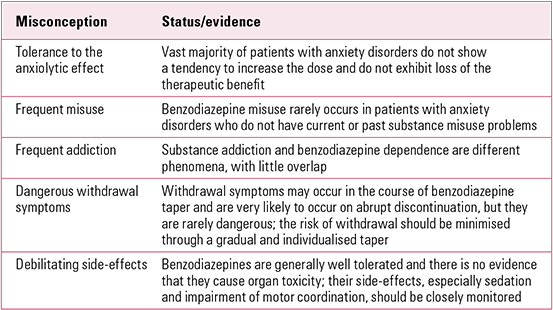
Despite these myths, there is a relative paucity of studies of long-term benzodiazepine use in patients with anxiety disorders. The myths and evidence will be discussed, with the goal of providing a more balanced view of the benefits and risks of long-term benzodiazepine use. It should be noted that research findings have implications only for patients with an anxiety disorder who do not have a propensity for substance use disorders and who do not have a personality disturbance (e.g. borderline, antisocial or dependent personality disorders) that might make it more difficult for them to cease benzodiazepine use.
Tolerance
There have been reports of patients who needed to increase the dose of benzodiazepines to continue experiencing the initial anti-anxiety effect. However, several studies (Reference Nagy, Krystal and WoodsNagy 1989; Reference Pollack, Otto and TesarPollack 1993; Reference Worthington, Pollack and OttoWorthington 1998; Reference Soumerai, Simoni-Wastila and SingerSoumerai 2003) have shown that during long-term treatment with benzodiazepines, the vast majority of patients do not have a tendency to increase the dose. Three of these studies (Reference Nagy, Krystal and WoodsNagy 1989; Reference Pollack, Otto and TesarPollack 1993; Reference Worthington, Pollack and OttoWorthington 1998) also reported no loss of therapeutic benefit of clonazepam and alprazolam in the course of long-term (up to 2.5 years) treatment, suggesting that there was no tolerance to the anxiolytic effects of these drugs.
Dependence, misuse and addiction
Dependence
Patients with anxiety disorders treated continuously with benzodiazepines for several weeks develop therapeutic or non-addictive dependence. This dependence is pharmacological (physical) in nature; it is a consequence of the physiological adaptation at the receptor level to the continuous use of benzodiazepines (Reference HaefelyHaefely 1986). The main implication of therapeutic dependence is that people using benzodiazepines for a long time should not cease them abruptly because of the likelihood of withdrawal symptoms; therapeutic dependence does not mean misuse, drug-seeking or lack of benefit (Reference RosenbaumRosenbaum 2005). It is crucial to distinguish therapeutic benzodiazepine dependence from benzodiazepine misuse and dependence related to true addiction.
Misuse
Benzodiazepine misuse is a pattern of indiscriminate use with harmful behaviour (e.g. stealing to obtain the medication), often with a tendency to increase the dose. In the absence of a history of alcohol or other substance misuse or dependence, benzodiazepine misuse among patients with anxiety disorders is rare (Reference SalzmanSalzman 1991; Reference Salzman, Miyawaki and le BarsSalzman 1993; Reference Andersch and HettaAndersch 2003). Patients with anxiety disorders on long-term treatment who have developed physical dependence are not misusing benzodiazepines (Reference O'BrienO’Brien 2005). Likewise, patients with anxiety disorders who have no tendency to misuse alcohol or other drugs, usually need not worry that they will end up misusing benzodiazepines.
Addiction
Addiction encompasses an intense craving for and preoccupation with a substance, uncontrollable drug-seeking behaviour, tolerance, adverse health and/or social consequences, and occurrence of withdrawal symptoms on abrupt discontinuation of the substance (Table 2). Of these characteristics, benzodiazepines are only associated with withdrawal symptoms on abrupt discontinuation. Although craving for benzodiazepines has been described, it occurs mainly in the context of craving for other substances or as a consequence of personality-level psychopathology (e.g. Reference Mol, Gorgels and VoshaarMol 2005).
TABLE 2 comparison between benzodiazepine dependence occurring in the course of long-term use for anxiety disorders and substance addiction
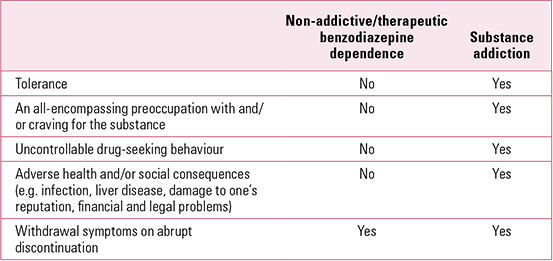
Pharmacological v. psychological dependence
Distinction also needs to be made between pharmacological and psychological dependence. Although all people taking benzodiazepines for prolonged periods of time become pharmacologically dependent, only some develop psychological dependence. The latter refers to the manifestations of dependence that are not based on the pharmacological actions of benzodiazepines. For example, people who ‘must’ carry their benzodiazepine wherever they go, may believe that the medication prevents anxiety in some magical way. This is sometimes referred to as ‘talisman dependence’ and is a good example of the use of medication as a safety device. Another type of psychological dependence occurs in people who have been gradually decreasing the dose to the point of taking a minimal dose, but then they are unable to complete the taper (‘last-dose dependence’). This is a consequence of the protective role attributed to the medication and patients’ unwillingness to face anxiety without relying on the medication.
Withdrawal symptoms and return of anxiety after cessation of benzodiazepines
Benzodiazepine withdrawal syndrome is often portrayed as dangerous and it is therefore dreaded by both patients and physicians. In fact, some patients continue taking benzodiazepines only to avoid withdrawal. This intensifies their fear that they will not be able to stop the medication and reinforces the notion that benzodiazepines are addictive.
Most withdrawal symptoms are not specific and resemble a recurrence of an anxiety disorder (Box 5). Relatively specific symptoms can help in recognising withdrawal syndrome, but they are not always present. Seizures are the most serious feature of benzodiazepine withdrawal, but they are rare. Withdrawal symptoms are rarely life threatening, they do not last very long (from several days to 2–3 weeks), usually leave no consequences, and often disappear without the need for treatment.
BOX 5 Characteristics of benzodiazepine withdrawal syndrome
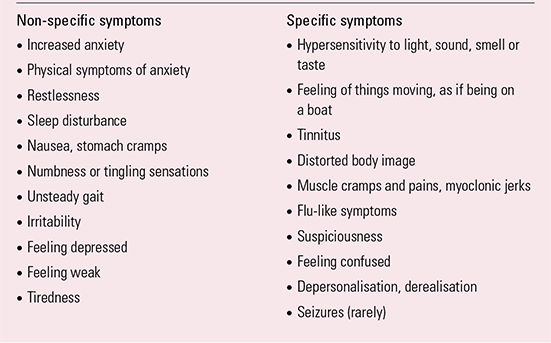
Non-specific symptoms
|
Specific symptoms
|
Tapering medication
Benzodiazepine withdrawal syndrome should be neither overestimated nor trivialised. The likelihood of withdrawal should be minimised through a very gradual and individualised tapering schedule before the medication is stopped entirely. Depending on the dose, the type of benzodiazepine (short-acting, intermediate-or long-acting), duration of its use, and the patient’s overall condition and personality characteristics, the taper can be completed in weeks or over a period of many months. As an example, a decrease in the total daily dosage by 0.25 mg of alprazolam over 1–2 weeks or by 0.125–0.25 mg of clonazepam over 1–2 weeks should be adequate to minimise the risk of withdrawal symptoms for most patients.
Patients need to feel ready for benzodiazepine discontinuation in order for it to be successful. In other words, they need to indicate that they feel capable of coping with the anxiety without having to continuously rely on the medication. If patients resist cessation, it is a bad idea to antagonise them by insisting that they stop ‘no matter what’. Refusing to continue prescribing a benzodiazepine or using other coercive measures is only likely to lead to more difficulties. It is also important to be flexible about the duration of taper, for example, by not setting rigid time limits.
The taper should ideally proceed under the physician’s supervision because they are best placed to suggest the pace of decreasing the dose, to monitor the patient’s progress and to provide support. The last is especially important if withdrawal symptoms occur during taper or if patients become ambivalent about continuing the taper. Cognitive–behavioural therapy (CBT) may also be effective in facilitating benzodiazepine discontinuation (Reference Otto, Pollack and SachsOtto 1993; Reference Spiegel, Bruce and GreggSpiegel 1994).
Rebound and relapse
Rebound refers to the return of anxiety symptoms within several days of benzodiazepine cessation. These symptoms resemble the manifestations of anxiety before the onset of treatment, but they are more severe. It may be difficult to distinguish rebound from withdrawal syndrome.
A full-blown relapse, usually occurring several weeks or months after medication cessation, is another possible outcome of benzodiazepine discontinuation. There is some indication that relapse rates may be higher after cessation of benzodiazepines than after cessation of anti-depressants (Reference Noyes, Garvey and CookNoyes 1991).
Both rebound and relapse may call for recommencement of the original pharmacotherapy, consideration of a different pharmacological approach, or a combination of pharmacological and psychological interventions. Adding CBT to ongoing pharmacotherapy may decrease the risk of relapse by introducing effective anxiety management techniques, fostering a more active approach to treatment, and improving coping and self-efficacy (Reference Biondi and PicardiBiondi 2003).
Side-effects
Sedation
Benzodiazepines are generally well tolerated. Their most common side-effect is sedation. For the most part, sedation is dose dependent, so that the higher the dose, the more likely it is for people to feel slowed down, tired, drowsy or even sleepy. Sedation typically occurs at the very beginning of treatment or immediately after the dose has been increased. Most people develop tolerance to the sedative effects of benzodiazepines, and the initial dose that caused sedation ceases to do so within 1–2 weeks of continued administration (Reference Shader and GreenblattShader 1993). As a result, sedation usually disappears and is generally not a problem for patients on a stable dose of medication. Unless sedative effects persist, the dose need not be decreased.
Psychomotor impairment
Another common and potentially troublesome side-effect is interference with psychomotor performance. This may affect complex skills such as driving (e.g. Reference Rapoport, Lanctot and StreinerRapoport 2009), and a link between benzodiazepine use and motor vehicle accidents has been suggested (e.g. Reference Barbone, McMahon and DaveyBarbone 1998). This interference requires careful monitoring, especially during the initial stages of treatment and while the dose is being increased. However, calls to limit prescription of benzodiazepines because of their possible interference with driving have not been widely supported, as some studies failed to relate long-term benzodiazepine use to psychomotor impairment (e.g. Reference Lucki, Rickels and GellerLucki 1986).
It has also been suggested that no dose or serum level of a benzodiazepine has been clearly associated with impairment of driving ability (Reference FreemanFreeman 2009) and that limiting benzodiazepine prescription ‘across the board’ is not warranted for this reason. Nevertheless, impairment of motor coordination is dose dependent, so patients should not drive or operate machines immediately after a dose increase.
Use with elderly patients
Excessive sedation and impaired psychomotor performance may be particularly troublesome in the elderly, as this may lead to falls and fractures. Although it has not been confirmed that hip fracture rates in the elderly are necessarily associated with benzodiazepine use (Reference Wagner, Ross-Degnan and GurwitzWagner 2007), elderly patients should use benzodiazepines with caution and at the lowest possible dose.
Interactions with alcohol
People taking benzodiazepines should avoid alcohol, because the combination of alcohol and benzodiazepines intensifies the sedative effects of the drug and may further impair motor coordination.
Amnesia
Anterograde amnesia occurs relatively frequently and refers to a difficulty remembering what happened in the period of up to several hours after a benzodiazepine has been taken. In most cases, memory can still be retrieved, although with some effort. This side-effect can be disturbing, especially to patients who need to remember what they have learnt in the period after taking a benzodiazepine.
Disinhibition
Disinhibition, manifested through irritability, anger and/or behaviour that is inappropriate, ‘out of character’ or aggressive, is not a common side-effect (Reference Rothschild, Shindul-Rothschild and VigueraRothschild 2000). Still, individuals with emotionally unstable personalities, immaturity, impulse control problems, brain damage and substance misuse may be more likely to exhibit disinhibition, and it may be prudent to avoid benzodiazepines in these circumstances.
Cognitive abnormalities
There are conflicting views on the association of benzodiazepines with cognitive abnormalities. A meta-analytic study of the cognitive effects of long-term benzodiazepine use (Reference Barker, Greenwood and JacksonBarker 2004), suggesting a significant decline in all cognitive domains, had serious methodological flaws. One brain imaging study (Reference Busto, Bremner and KnightBusto 2000) did not find benzodiazepine-induced brain abnormalities that could underlie cognitive changes. Significant cognitive impairment is rarely observed in the course of long-term benzodiazepine treatment of anxiety disorders (Reference Deckersbach, Moshier and Tuschen-CaffierDeckersbach 2011), but subtle changes may occur, calling for further research.
Depression
Although it is occasionally reported that benzodiazepines cause depression or make depressive symptoms worse, there is no conclusive evidence that these drugs are depressogenic.
Ensuring effective and safe use of benzodiazepines
Benzodiazepines are not ideal drugs for treating anxiety disorders. Like other pharmacological agents, they have advantages and disadvantages, but the latter have been emphasised at the expense of the former. Considering that a need for pharmacological management of anxiety disorders is not likely to disappear, it is time to reappraise the role of benzodiazepines in the treatment of anxiety disorders and make recommendations for their effective and safe use (Box 6).
BOX 6 Measures to ensure safe, effective use of benzodiazepines for anxiety disorders
-
• Careful selection of patients who might benefit from benzodiazepines
-
• Administration of benzodiazepines in clinical situations in which they are more likely to be useful (see Box 3)
-
• If possible, administration in a lower dose, for a short period of time, and in conjunction with an antidepressant
-
• Careful monitoring and management of side-effects
-
• Right ‘timing’ for benzodiazepine cessation
-
• Careful, gradual and individualised benzodiazepine taper to prevent or alleviate withdrawal symptoms
First, there should be careful consideration of the type of patient who might benefit from benzodiazepines, for example, a person with panic disorder. These medications are not effective in PTSD and OCD and they are generally not very useful in generalised anxiety disorder and social anxiety disorder if administered alone. People with current or past substance misuse problems and those with severe personality disorder are generally unsuitable for treatment with benzodiazepines because of their propensity to misuse agents with dependence-producing capability.
Second, the administration of benzodiazepines should be considered in clinical situations in which they are most likely to be useful. These include presence of severe symptoms of anxiety and tension, frequent and severe panic attacks, sleep disturbance, restlessness and agitation, especially when patients have great difficulty tolerating these symptoms and request immediate relief.
Third, benzodiazepines should ideally be administered in a lower dose, for a short time (e.g. 6–10 weeks) and in conjunction with an anti-depressant. However, long-term monotherapy with benzodiazepines is a viable and justified option.
Fourth, side-effects of benzodiazepines should be carefully monitored and managed (e.g. by adjusting the dosage accordingly).
Finally, benzodiazepine cessation should be considered only when the patient is ready. Once the decision has been made to discontinue, this should be done carefully, gradually and in close collaboration with the physician to minimise the risk of withdrawal syndrome.
MCQs
Select the single best option for each question stem
-
1 Reasons for the ongoing popularity of benzodiazepines in the treatment of anxiety disorders include:
-
a their greater effectiveness than antidepressants
-
b their effectiveness against the cognitive symptoms of anxiety (e.g. pathological worry)
-
c quick onset of anti-anxiety effect
-
d their effectiveness for all anxiety disorders
-
e favourable effect on co-occurring depressive illness.
-
-
2 Clinical situations in which benzodiazepines may be considered as the initial treatment for anxiety disorders include:
-
a presence of OCD
-
b presence of severe panic attacks and anxiety for which quick relief is requested
-
c presence of social anxiety disorder in conjunction with current alcohol misuse
-
d presence of generalised anxiety disorder and major depression
-
e presence of PTSD.
-
-
3 Characteristics of benzodiazepine dependence occurring in the course of their long-term use include:
-
a tolerance to the anxiolytic effects of benzodiazepines
-
b an all-encompassing preoccupation with and/or craving for benzodiazepines
-
c uncontrollable benzodiazepine-seeking behaviour
-
d adverse health and/or social consequences
-
e withdrawal symptoms on abrupt discontinuation.
-
-
4 Relatively specific symptoms of benzodiazepine withdrawal syndrome include:
-
a restlessness
-
b tiredness
-
c hypersensitivity to light, sound, smell or taste
-
d insomnia
-
e irritability.
-
-
5 Measures to ensure effective and safe use of benzodiazepines in anxiety disorders include:
-
a benzodiazepine cessation as soon as possible, even if the patient is not agreeable
-
b careful selection of patients who might benefit from benzodiazepines
-
c their use on an as-needed (p.r.n.) basis only
-
d frequent testing of cognitive functioning, even in younger patients
-
e use of carbamazepine to prevent withdrawal symptoms.
-
MCQ answers

| 1 | c | 2 | b | 3 | e | 4 | c | 5 | b |


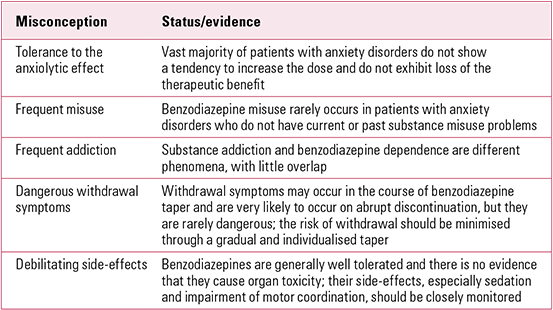
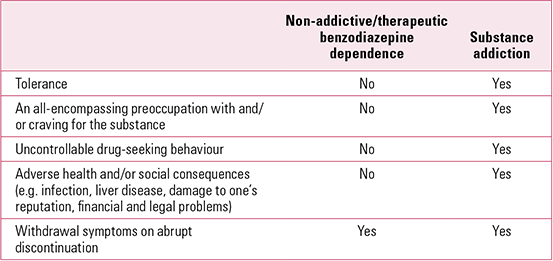


eLetters
No eLetters have been published for this article.